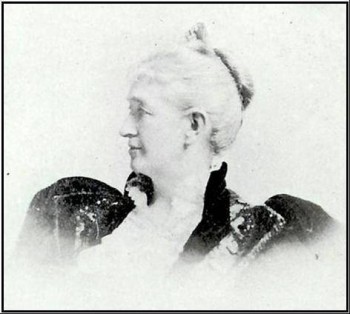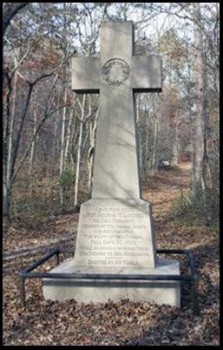On a wooded hiking trail on the northwest section of the Chickamauga National Battlefield, stands a monument to a fallen soldier. Dedicated in 1909, the inscription on the base reads…
Near this spot
Lieut. George W. Landrum
2d Ohio Regiment,
Member of the signal Corps.,
And serving upon
The Staff of Gen. Thomas,
Fell Sept. 20, 1863,
While bearing a message from
Gen. Thomas to Gen. Rosecrans.
Erected by his family
In 1894, Amanda Landrum Wilson, the wife of a wealthy Ohio book publisher, called on fellow Cincinnatian General Henry Van Ness Boynton, a Civil War Medal of Honor recipient and president of the Chickamauga Park Commission. Mrs. Wilson wanted to locate the place where her brother, the Lieutenant, had died. Further correspondence led to the involvement of three Fayetteville, Tennessee men and veterans of the 41st Tennessee Infantry, Colonel James D. Tillman, Captain James R. Feeney, and Charles B. Bagley (an 18 year-old private at the time of Lieutenant Landrum’s death).
An entry in the Lincoln County newspapers said the men were traveling to the battlefield on the invitation of General Boynton to “…to locate…where Lieut. Landrum was killed…Mrs. Wilson, a sister of Lieut. Landrum, has been authorized to erect a monument to her brother, who was killed in front of the 41st Tenn. Regt., while reconnoitering as a staff officer of Gen. Rosecrans. Mr. C. B. Balgey fired the first shot at him and Mr. John Jobe, of the same regiment tumbled him to the ground.” By the way, Bagley was seriously wounded and carried off the field of battle the same day.John Harvey Jobe (1826 – 1896) and his brother Stephen, also of the 41st, were from Boonshill, Tennessee sons of North Carolinian Samuel Caruthers Jobe, an early settler who first came to Lincoln County in 1819. Stephen died at Vicksburg, Mississippi in January of 1863.
The correspondence in 1894 between the Confederate veterans and Mrs. Wilson is quite moving and some of it was included in a beautifully designed program for the monument dedication ceremony. Both Colonel Tillman and Bagley readily admitted that Charles had fired at the Lieutenant yet Tillman praised Landrum for his courage:
…The incident…has been spoken of at reunions of Confederate soldiers and around the domestic fireside and on hunting and fishing excursions for more than twenty-five years, but none of us ever knew the name of the officer…
Bagley added this…
I assure you it gave me great pleasure to be of service to you and Mrs. Wilson in helping to locate the spot where your dear one fell. I join you in all honor to the brave spirits on both sides who gave up their lives in defense of what they thought was right. Immediately, after meeting you on your arrival at Chattanooga, there came over me a peculiar sadness I never felt before, and on retiring that night I asked the Lord to guide us to the spot where Lieutenant Landrum fell, for the loving sister’s sake. The prayer was answered…
Yet another Confederate officer from Mt. Pleasant, 1st Lieutenant Robert Rainy Williams from the 3rd Tennessee Infantry, wrote to Mrs. Wilson:
…Especially do I recall the fate of the brave cavalier, who, so regardless of his fate and intent on delivering his dispatches, attempted to run the gauntlet of our line of skirmishers…I have often wondered who this person was and what was his errand and rank. The flight of his beautiful gray steed, seemingly conscious of the importance of his mission, and the manly, erect, dignified bearing of the rider, to whom danger seemed to develop his fullest stature, recalled to me more than anything I ever saw, the stirring description of the heroic knights of ancient chivalry.
When Lieutenant Landrum fell, he was separated from his company and attended by a Confederate surgeon. For six months his family and friends went to great lengths to find him. He was listed missing in action until Dr. James Turner Sanford Thompson of Spring Hill, surgeon for the 3rd Tennessee, was captured by the 9th Illinois Mounted Infantry in Decatur, Alabama (said to be one of six times he was captured and escaped).
Upon learning the Union doctor attending him was from Cincinnati, Dr. Thompson asked the surgeon to deliver a message to the Landrum family:
Lieutenant George Landrum, of Cincinnati, received his mortal wound on the 20th day of September, 1863, during the battle of Chickamauga. He lived about two hours after receiving the wound, a portion of which time he suffered very much. A Minie ball passed through the pelvis, penetrating the bladder. He was on his horse, riding in a gallop, at the time he received the wound…I gave him a small dose of morphine. After he had grown easy he asked me to give him my candid opinion of his condition. When I told him that I thought he would certainly die in a short time, he remarked that he was not afraid to die; that he had the consolation of knowing that he was dying in a glorious cause. He requested me, if I had an opportunity, to inform his relatives of his death, and how he died…
Ironically, Lieutenant Landrum was born into a “sterling old Southern family” who came to Virginia in the 1680s. George’s father, a prominent pioneer preacher, Reverend Francis Landrum, moved the family to Kentucky where he died when George was four years old. George’s mother was pregnant at the time and had six other children ranging in age from two to sixteen. The mother soon moved across the Ohio River to Cincinnati where George, the only son, worked to support his family and educate his younger sisters – which included Amanda.
In the dedication program, Amanda wrote of her brother,
He gave much promise of a successful career as a man of affairs. But…the war god, Mars, summoned him to other fields and ruthlessly sacrificed his superb young manhood upon the altar of war.
Like thousands of comrades equally as brave and patriotic as himself, he did his duty nobly and his highly commendable record is unspotted by a single, unsoldierly act.



